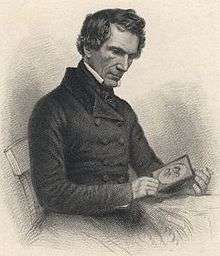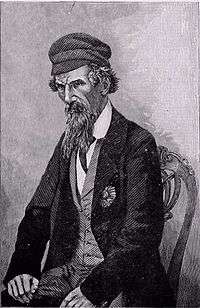Henry Montgomery Lawrence
| Brigadier-General Sir Henry Montgomery Lawrence KCB | |
|---|---|
.jpg) | |
| Born |
28 June 1806 Ceylon |
| Died |
4 July 1857 (aged 51) Lucknow, British India |
| Allegiance |
|
| Service/branch | Bengal Army |
| Years of service | 1823–1857 |
| Rank | Brigadier-General |
| Unit | Bengal Artillery |
| Battles/wars |
First Burmese War First Anglo-Afghan War First Anglo-Sikh War Second Anglo-Sikh War Indian Mutiny |
| Awards |
|
| Relations |
John Lawrence, 1st Baron Lawrence Sir George St Patrick Lawrence |
| Other work |
Resident Minister at Lahore Chief Commissioner of Awadh |
Sir Henry Montgomery Lawrence KCB (28 June 1806 – 4 July 1857) was a British soldier and statesman in India, who died in the Siege of Lucknow during the Indian Rebellion. He is remembered in the Indian subcontinent as founder of the four Lawrence Military Asylums.
Career

Lawrence was born in 1806 into an Irish family at Matara, Ceylon the eldest son of Lieutenant-Colonel Alexander William Lawrence and the brother of John Lawrence, 1st Baron Lawrence. Educated at Foyle College, Derry and then Addiscombe Military Seminary, in 1823 he joined the Bengal Artillery at the Calcutta suburb of Dum Dum, where Henry Havelock was also stationed about the same time. In the first Burmese War, Lawrence and his battery formed part of the Chittagong column which General Morrison led over the jungle-covered hills of Arakan, until fever decimated them, and Lawrence found himself back in Britain, wasted by a disease that never completely left him. He returned to India in 1829, and was appointed revenue surveyor by Lord William Bentinck at Gorakhpur. He spent some years in camp, during which he married his cousin Honoria Marshall, and surveyed every village in four districts, each larger than Yorkshire. He was then recalled to a brigade by the outbreak of the First Afghan War towards the close of 1838.
As assistant to Sir George Russell Clerk, he now added to his political experience in the management of the district of Ferozepore; and when news of disaster came from Kabul in November 1841 he was sent to Peshawar in order to push up supports for the relief of Sale and the garrison of Jalalabad. He was often unpopular with higher authorities due to his insistence that government should pay most attention to the welfare of the Indian population. He became the British Resident Minister in Nepal from December 1843 to 1845.
At the end of the First Anglo-Sikh War, the Treaties executed provided for a garrison to be based in Lahore. Lawrence remained there as Agent to the Governor General in charge of political relations of the British government with the Darbar.[1] By the Treaty of Bhairowal (1846), he was made the Resident at Lahore as well as Agent to the Governor-General for the North West Frontier.[1] While here, he governed the area with the help of a group of officers, later known as Henry Lawrence's "Young Men".

In 1856, he was appointed to the newly annexed province of Awadh as Chief Commissioner. In 1857 during the Indian Mutiny (Revolt of 1857), the Siege of Lucknow took place in the province and the British community, including the garrison of some 1700 men, took refuge in the British residency when the siege began on 30 June. Commander Henry Lawrence was one of the first casualties, being wounded by an exploding shell on 2 July and dying two days later. When Lawrence was critically injured, he is supposed to have said to those around him: "Put on my tomb only this; Here lies Henry Lawrence who tried to do his duty." This epitaph appears on his tombstone at the Residency graveyard.
Educational institutions
Lawrence established institutions for the education of the children of British soldiers, known as the Lawrence Military Asylums, at four places in British India. Three of these institutions survive today as the prestigious Lawrence School, Sanawar (HP, India), Lawrence School, Lovedale (TN, India) and Lawrence College, Ghora Gali (Murree, Pakistan): the fourth, which does not survive, was at Mount Abu, in present-day Rajasthan.
Following the Disruption of 1843, along with Sir James Outram, Lawrence supported Reverend Alexander Duff in establishing the Free Church Institution in Kolkata, as a rival institution to the General Assembly's Institution, which had been founded by Duff in 1830.[2][3] These two institutions would later be merged to form the Scottish Churches College, known since 1929 (when the Church of Scotland was unified) as Scottish Church College.[4]
Family life
Lawrence married Honoria Marshall in 1837 but she died in 1854.[5]

Works
- Lawrence, H. M. L. (1845). Adventures of an Officer in the Service of Runjeet Singh. London: Henry Colburn.
- Lawrence, Henry Montgomery (1859). Essays, Military and Political, Written in India. London: W. H. Allen & Co.
- Lawrence also contributed to the Calcutta Review.
Commemoration
Lawrence is commemorated by a high cross in the cemetery adjacent to the Residency in Lucknow.
He is also remembered in the names of:
- Henry Lawrence Island in the Indian Ocean, at 12N 93E.
- The town of Lawrence in New Zealand.
References
- 1 2 Political Diaries of the Agent to the Governor General, North West Frontier and Resident at Lahore from 1 January 1847 to 4 March 1848 (reprint ed.). Lahore: Sang-e-Meel Publications. 2005. p. i. ISBN 969-35-1766-0.
- ↑ Pitlochry Church of Scotland's obituary of Alexander Duff
- ↑ The missionary’s mission in Calcutta
- ↑ History of Scottish Church College
- ↑ "The Late Sir Henry Lawrence, K.C.B." Times [London, England] 24 Aug. 1857: 7. The Times Digital Archive. Web. 3 Apr. 2013.
 Chisholm, Hugh, ed. (1911). "Lawrence, Sir Henry Montgomery". Encyclopædia Britannica. 16 (11th ed.). Cambridge University Press. pp. 305–306.
Chisholm, Hugh, ed. (1911). "Lawrence, Sir Henry Montgomery". Encyclopædia Britannica. 16 (11th ed.). Cambridge University Press. pp. 305–306.
Further reading
- "Lawrence, Sir Henry Montgomery". Oxford Dictionary of National Biography (online ed.). Oxford University Press. doi:10.1093/ref:odnb/16179. (Subscription or UK public library membership required.)
- Vibart, H.M. (1894). Addiscombe: its heroes and men of note. Westminster: Archibald Constable. pp. 353–64.
- James John McLeod Innes (1898). Sir Henry Lawrence: The Pacificator. Rulers of India series. Clarendon Press.
External links
| Wikisource has the text of The New Student's Reference Work article Lawrence, Sir Henry Montgomery. |
- Illustrated London News 24 Oct 1863 - p.415 The Lawrence Asylum at Murree
- Sir Henry Lawrence
- The Second Anglo Sikh War
- The Columbia Encyclopedia, Sixth Edition
- Lawrence School, Lovedale
- Lawrence College, Ghora Gali, Murree, Pakistan
- Lawrence School, Sanawar
- Portraits of Sir Henry Montgomery Lawrence at the National Portrait Gallery, London
